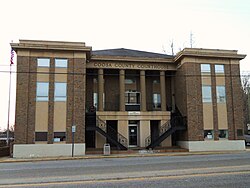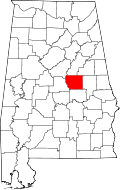Demographics
Historical population| Census | Pop. | Note | %± |
|---|
| 1840 | 6,995 | | — |
|---|
| 1850 | 14,543 | | 107.9% |
|---|
| 1860 | 19,273 | | 32.5% |
|---|
| 1870 | 11,945 | | −38.0% |
|---|
| 1880 | 15,113 | | 26.5% |
|---|
| 1890 | 15,906 | | 5.2% |
|---|
| 1900 | 16,144 | | 1.5% |
|---|
| 1910 | 16,634 | | 3.0% |
|---|
| 1920 | 14,839 | | −10.8% |
|---|
| 1930 | 12,460 | | −16.0% |
|---|
| 1940 | 13,460 | | 8.0% |
|---|
| 1950 | 11,766 | | −12.6% |
|---|
| 1960 | 10,726 | | −8.8% |
|---|
| 1970 | 10,662 | | −0.6% |
|---|
| 1980 | 11,377 | | 6.7% |
|---|
| 1990 | 11,063 | | −2.8% |
|---|
| 2000 | 12,202 | | 10.3% |
|---|
| 2010 | 11,539 | | −5.4% |
|---|
| 2020 | 10,387 | | −10.0% |
|---|
| 2024 (est.) | 10,291 | [4] | −0.9% |
|---|
|
2020 census
As of the 2020 census, the county had a population of 10,387. The median age was 48.9 years. 17.2% of residents were under the age of 18 and 23.1% of residents were 65 years of age or older. For every 100 females there were 101.3 males, and for every 100 females age 18 and over there were 101.4 males age 18 and over. [9] [10]
The racial makeup of the county was 65.7% White, 29.0% Black or African American, 0.3% American Indian and Alaska Native, 0.1% Asian, 0.0% Native Hawaiian and Pacific Islander, 1.6% from some other race, and 3.4% from two or more races. Hispanic or Latino residents of any race comprised 1.9% of the population. [10]
0.0% of residents lived in urban areas, while 100.0% lived in rural areas. [11]
There were 4,451 households in the county, of which 24.1% had children under the age of 18 living with them and 27.7% had a female householder with no spouse or partner present. About 31.5% of all households were made up of individuals and 14.1% had someone living alone who was 65 years of age or older. [9]
There were 5,999 housing units, of which 25.8% were vacant. Among occupied housing units, 78.2% were owner-occupied and 21.8% were renter-occupied. The homeowner vacancy rate was 1.4% and the rental vacancy rate was 5.7%. [9]
Racial and ethnic composition
Coosa County, Alabama – Racial and ethnic composition
Note: the US Census treats Hispanic/Latino as an ethnic category. This table excludes Latinos from the racial categories and assigns them to a separate category. Hispanics/Latinos may be of any race.| Race / Ethnicity (NH = Non-Hispanic) | Pop 2000 [12] | Pop 2010 [13] | Pop 2020 [14] | % 2000 | % 2010 | % 2020 |
|---|
| White alone (NH) | 7,742 | 7,604 | 6,807 | 63.45% | 65.90% | 65.53% |
| Black or African American alone (NH) | 4,147 | 3,556 | 3,000 | 33.99% | 30.82% | 28.88% |
| Native American or Alaska Native alone (NH) | 39 | 40 | 25 | 0.32% | 0.35% | 0.24% |
| Asian alone (NH) | 5 | 14 | 8 | 0.04% | 0.12% | 0.08% |
| Native Hawaiian or Pacific Islander alone (NH) | 0 | 0 | 0 | 0.00% | 0.00% | 0.00% |
| Other race alone (NH) | 9 | 7 | 47 | 0.07% | 0.06% | 0.45% |
| Mixed race or Multiracial (NH) | 102 | 88 | 299 | 0.84% | 0.76% | 2.88% |
| Hispanic or Latino (any race) | 158 | 230 | 201 | 1.29% | 1.99% | 1.94% |
| Total | 12,202 | 11,539 | 10,387 | 100.00% | 100.00% | 100.00% |
2010 census
As of the census [15] of 2010, there were 11,539 people, 4,794 households, and 3,293 families living in the county. The population density was 18 people per square mile (6.9 people/km2). There were 6,478 housing units at an average density of 9.7 per square mile (/km3.8). The racial makeup of the county was 66.3% White, 31.0% Black or African American, 0.3% Native American, 0.1% Asian, 0.1% Pacific Islander, 1.2% from other races, and 0.9% from two or more races. 2.0% of the population were Hispanic or Latino of any race.
There were 4,794 households, out of which 23.0% had children under the age of 18 living with them, 49.5% were married couples living together, 14.1% had a female householder with no husband present, and 31.3% were non-families. 27.9% of all households were made up of individuals, and 11.1% had someone living alone who was 65 years of age or older. The average household size was 2.38 and the average family size was 2.89.
In the county, the population was spread out, with 20.5% under the age of 18, 7.4% from 18 to 24, 23.2% from 25 to 44, 31.8% from 45 to 64, and 17.1% who were 65 years of age or older. The median age was 44.2 years. For every 100 females, there were 98.5 males. For every 100 females age 18 and over, there were 98.7 males.
The median income for a household in the county was $35,560, and the median income for a family was $47,451. Males had a median income of $40,315 versus $26,826 for females. The per capita income for the county was $19,209. About 11.4% of families and 16.0% of the population were below the poverty line, including 20.6% of those under age 18 and 14.2% of those age 65 or over.
From 2000 to 2003, Coosa County's growth rate of -5.8% made it the biggest percentage population loser among the state's 67 counties. [16] Annette Jones Watters of the University of Alabama's Alabama State Data Center cited Coosa as one of eight counties to lose greater than 6% of its population from 2000 to early 2007. [17]
2000 census
As of the census [18] of 2000, there were 12,202 people, 4,682 households, and 3,408 families living in the county. The population density was 19 people per square mile (7.3 people/km2). There were 6,142 housing units at an average density of 9 units per square mile (3.5 units/km2). The racial makeup of the county was 63.94% White, 34.19% Black or African American, 0.32% Native American, 0.04% Asian, 0.01% Pacific Islander, 0.62% from other races, and 0.88% from two or more races. 1.29% of the population were Hispanic or Latino of any race.
There were 4,682 households, out of which 30.00% had children under the age of 18 living with them, 54.80% were married couples living together, 13.50% had a female householder with no husband present, and 27.20% were non-families. 24.30% of all households were made up of individuals, and 9.80% had someone living alone who was 65 years of age or older. The average household size was 2.52 and the average family size was 2.98.
In the county, the population was spread out, with 23.70% under the age of 18, 8.60% from 18 to 24, 29.00% from 25 to 44, 24.30% from 45 to 64, and 14.40% who were 65 years of age or older. The median age was 38 years. For every 100 females, there were 104.40 males. For every 100 females age 18 and over, there were 102.50 males.
The median income for a household in the county was $29,873, and the median income for a family was $36,082. Males had a median income of $25,390 versus $18,171 for females. The per capita income for the county was $14,875. About 11.80% of families and 14.90% of the population were below the poverty line, including 19.50% of those under age 18 and 13.40% of those age 65 or over.


